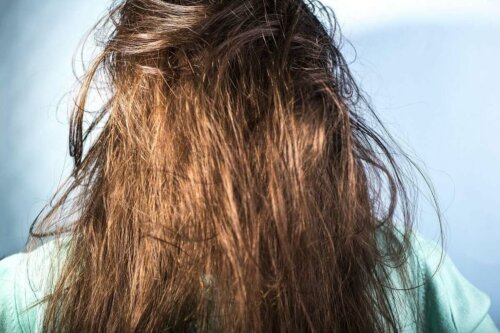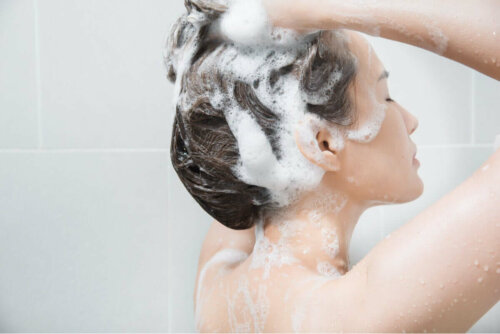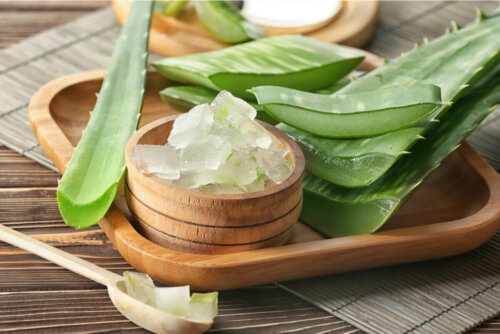The Best Tips to Wash Greasy Hair

If you have greasy hair, you need to take some recommendations into account to wash it properly. Due to excessive scalp sebum production, you must know how to choose the right products to avoid that greasy and dirty appearance. What else should you consider?
First, it’s important to know why grease builds up in the hair and what factors can make it worse. Then, you can take some simple measures to make it look better.
Keep reading to discover them!
What are the causes of greasy hair?
Under normal conditions, healthy hair secretes a certain amount of sebum to ensure good scalp hydration and keep the strands healthy. In fact, this sebum is considered a defense mechanism for the sensitive part of the roots.
And although the amount produced varies from person to person, improper hygiene, excess sweating, and other lifestyle factors can lead to excessive sebum. The result? Greasy and dirty-looking hair that’s difficult to style and treat.

But why do some people have greasy hair and others don’t? What causes sebum production to increase?
There are several possible causes. Below, we’ll explain the most common ones in detail.
Hormonal changes
These changes can cause overactive scalp sebaceous glands. As a result, they can make your hair look dirty. This is common among pregnant women, teens, or women who take birth control pills.
Washing your hair too often
Although people with greasy hair tend to wash it more regularly, washing it too much can be counterproductive. For what reason? Well, every time you rinse your hair with hair products, your scalp picks up a signal to produce more sebum.
Hair type
Altered scalp sebum production can affect anyone. However, those with fine and straight hair are at a higher risk of accumulating sebum. Since the hair isn’t wavy, the sebum slides more easily down the shaft.
Misuse of hair products
It’s essential to choose the right products to wash your greasy hair. Due to its characteristics, washing it only with water won’t remove the sebum. You also won’t accomplish a clean appearance with oil-based products. It’s important to choose a shampoo with compounds that break down sebum.
Also, you shouldn’t use too much conditioner. In fact, you should only apply it mid-length to tips. Make sure it contains as few greasy substances as possible.
Other possible causes
- Vigorous exercise (due to excessive sweating).
- Excessive use of hair treatments.
- Going outdoors with damp hair.
- Exposing hair to the sun or sources of heat.
Read on to learn more: Treat Oily Hair with Sea Salt
How to wash greasy hair correctly
Have you ever wondered what steps you should take to wash greasy hair? The process is actually quite simple. The key is to stimulate scalp pH balance and regulate sebum production. To achieve this, you have to know how to choose the right hair products and apply them correctly. Here are the steps you need to follow:
1. Be careful with your choice of hair products
Most hair products are designed for normal or dry hair. Their composition helps make your hair shinier and boosts moisture. However, it’s incompatible with greasy hair. If you’re trying to prevent this problem, it’s best to find an appropriate formula.
Fortunately, nowadays, you can find many products that can regulate sebum production. They range from light to micellar products. For example, ingredients made from green tea, citrus fruits, or aloe vera are good options.
2. Use warm or cold water
Water temperature also matters. More precisely, you must avoid washing your hair with hot water. Although it removes dirt and grease at the moment, it can lead to increased sebum production later on.
Therefore, it’s best to use warm or cold water. A good option is to start washing your hair with warm water and finish rinsing it with cold water to seal the hair cuticles.
3. Apply a product
One of the most important aspects you should take into account is when to apply hair products. Firstly, you need to consider the amount of shampoo you should apply. This will depend on how long and thick your hair is. You should use one to two tablespoons.
After that, you also need to pay attention to how you’ll apply it. It’s best to spread the shampoo all over your head and massage your scalp with your fingertips to clean the residue that accumulates there. Finally, and after a first rinse, apply a conditioner from mid-length to tips.

4. Hair washing frequency
Contrary to what many may think, you don’t need to wash greasy hair too often. As we mentioned above, this tends to alter its pH and can produce the opposite effect. Thus, it’s best to wash it every other day. To avoid that dirty hair feeling, you can even try dry shampoos.
5. Supplement your hair routine
In addition to the aforementioned tips, other hair care can also help you achieve clean and healthy hair. For example, it’s a good idea to apply masks with ingredients suited for greasy hair. You can also try a scalp scrub, as long as it is oil-free.
How to make hair less greasy
Proper washing can reduce your hair’s greasy appearance. Nevertheless, you can apply other tips to make your hair look better and avoid overactive sebum production. Try them out today!
Use essential oils
It may be beneficial to apply essential oils on your hair to control excessive sebum production on the scalp. Its properties break down sebum and facilitate hair follicle cleansing.
Here are the most recommended options:
- Tea tree essential oil
- Peppermint essential oil
- Chamomile essential oil
Dilute a couple of drops of these oils in water or in the shampoo you usually use. Another option is rosemary oil, which is also associated with healthy hair growth.
You don’t want to miss this article: Control Oily Hair with this DIY Dry Shampoo
Apply apple cider vinegar to treat greasy hair
To date, there’s no evidence on the hair health benefits of apple cider vinegar. However, anecdotal data suggests that using it moderately can make hair less greasy and prevent problems such as dandruff.
- All you have to do is dilute a couple of tablespoons of apple cider vinegar in two liters of water.
- Then, rinse your hair with the mixture.
- Lastly, wash your hair with shampoo and apply conditioner.
- You can apply this remedy two to three times a week.
Use an aloe vera mask
As with other home remedies, no scientific evidence backs the effectiveness of aloe vera to fight hair greasiness. Nevertheless, people have used it in natural cosmetics to help with excess sebum, dandruff, and damaged or split ends.
Here’s how to apply it:
- First, extract fresh gel from an aloe vera leaf.
- Then, massage it onto your scalp with gentle circular massages.
- Leave it on for 20 minutes and rinse.
- You can apply it two or three times a week.

Apply dry shampoo to greasy hair
It’s a good idea to apply dry shampoo on the roots after exercising or on a hot day, so it can absorb the sebum. You can find many different types of cosmetic or beauty stores or pharmacies. However, you mustn’t use it excessively.
Use cornstarch or baby powder
Cornstarch or baby powder can reduce greasiness due to sweat or heat. They’re quite similar to dry shampoos but have natural formulas. Just apply a small amount of the chosen product to the crown of your head and massage it.
Avoid brushing between washes
Excessive brushing also affects people with greasy hair. Brushing draws sebum and sweat from the scalp towards the cuticles. It’s best to not brush your hair too much until you get the greasiness under control. The same goes for hair straighteners and curlers.
You can prevent greasy hair
Excessive sebum production depends on many different factors. However, with proper washing and by applying some home remedies, you can improve your hair’s appearance.
Of course, remember that it’s important to incorporate the tips we shared here into your daily hair care routine.
All cited sources were thoroughly reviewed by our team to ensure their quality, reliability, currency, and validity. The bibliography of this article was considered reliable and of academic or scientific accuracy.
- Nayak BS, Ann CY, Azhar AB, Ling ECS, Yen WH, Aithal PA. A Study on Scalp Hair Health and Hair Care Practices among Malaysian Medical Students. Int J Trichology. 2017;9(2):58-62. doi:10.4103/ijt.ijt_76_16
- Szöllősi AG, Oláh A, Bíró T, Tóth BI. Recent advances in the endocrinology of the sebaceous gland. Dermatoendocrinol. 2018;9(1):e1361576. Published 2018 Jan 23. doi:10.1080/19381980.2017.1361576
- Draelos ZD. Essentials of Hair Care often Neglected: Hair Cleansing. Int J Trichology. 2010;2(1):24-29. doi:10.4103/0974-7753.66909
- Hoover E, Aslam S, Krishnamurthy K. Physiology, Sebaceous Glands. [Updated 2020 Jun 8]. In: StatPearls [Internet]. Treasure Island (FL): StatPearls Publishing; 2020 Jan-. Available from: https://www.ncbi.nlm.nih.gov/books/NBK499819/
- Bassino E, Gasparri F, Munaron L. Protective Role of Nutritional Plants Containing Flavonoids in Hair Follicle Disruption: A Review. Int J Mol Sci. 2020;21(2):523. Published 2020 Jan 14. doi:10.3390/ijms21020523
-
Vardy, D., Cohen, A., Tchetov, T., Medvedovsky, E., & Biton, A. (1999). A double-blind, placebo-controlled trial of anAloe vera (A. barbadensis)emulsion in the treatment of seborrheic dermatitis. Journal of Dermatological Treatment, 10(1), 7–11. https://doi.org/10.3109/09546639909055904
- Lawrence R, Tripathi P, Jeyakumar E. Isolation, Purification and Evaluation of Antibacterial Agents from Aloe vera. Braz J Microbiol. 2009;40(4):906-915. doi:10.1590/S1517-838220090004000023
- D’Souza P, Rathi SK. Shampoo and Conditioners: What a Dermatologist Should Know?. Indian J Dermatol. 2015;60(3):248-254. doi:10.4103/0019-5154.156355
- Gavazzoni Dias MF. Hair cosmetics: an overview. Int J Trichology. 2015;7(1):2-15. doi:10.4103/0974-7753.153450
This text is provided for informational purposes only and does not replace consultation with a professional. If in doubt, consult your specialist.








